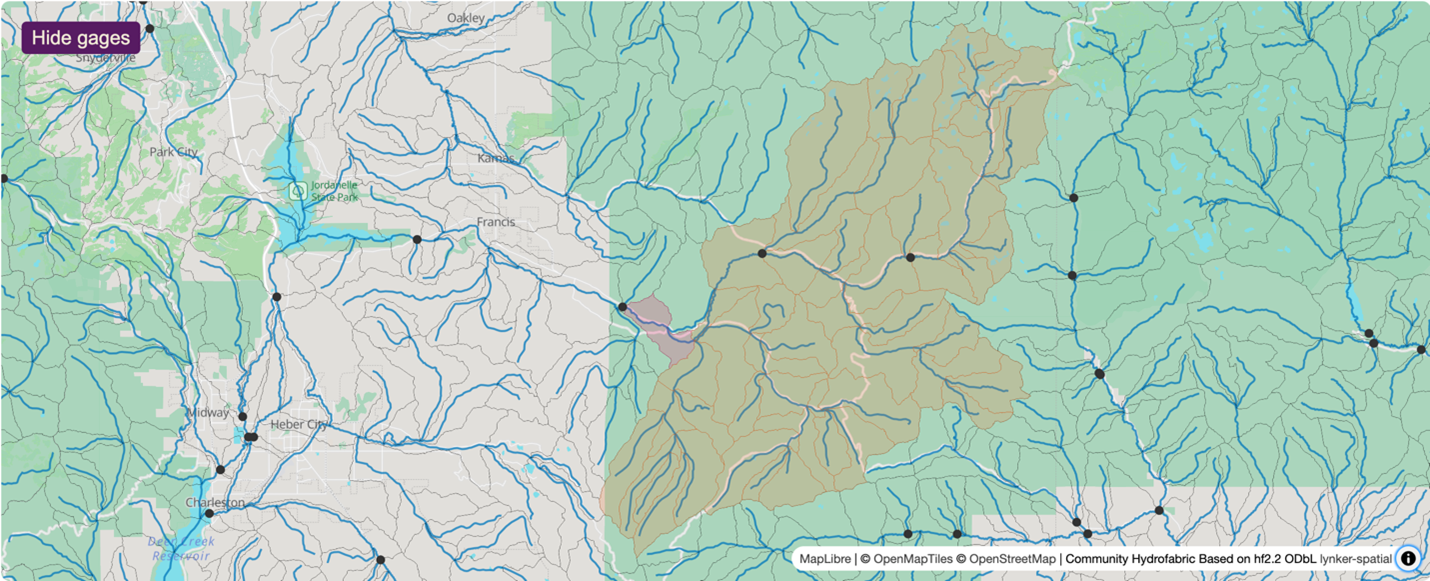Data Preparation
Last updated on 2025-05-09 | Edit this page
Overview
Questions
- How should I prepare my run directory?
- What is the Data Preprocess tool?
Objectives
- Identify the required data structure of a NextGen run in NGIAB
- Explain how the Data Preprocess tool interacts with NGIAB
- Prepare data for an NextGen run in NGIAB
Data Preprocess Tool
The Data Preprocess tool streamlines data preparation for NextGen runs in NGIAB. This tool provides a graphical user interface (GUI) and a command line interface (CLI) to prepare input data and execute model runs. A graphical user interface facilitates catchment and date range selection options via an interactive map, simplifying the subsetting of hydrofabrics, generation of forcings, and creation of default NextGen realizations. While this module reduces procedural complexity, it incorporates pre-defined assumptions that may limit user flexibility in specific applications (Cunningham, 2025).
Installing and Using the Data Preprocess Tool
The Data Preprocess tool (like all of our software) is constantly being updated and refined. As of the time of writing (see last updated date above), there are two ways to run the tool. Instructions for installation, environment management, and the GUI/CLI are found on the Data Preprocess GitHub page. We will cover some examples of the CLI usage, but full documentation is on the GitHub page.
Example 1
This command allows you to run the Data Preprocess CLI tool without installing it. It produces forcings and a NextGen realization file for the catchments upstream of gage-10154200 for the time period 2017-09-01 to 2018-09-01. Forcing data is sourced from the zarr files in the Analysis of Record for Calibration (AORC) dataset, which allows for a faster processing time.
Astral UV is required to run the Data Preprocess tool without installing it.
BASH
uvx --from ngiab_data_preprocess cli -i gage-10154200 -sfr --start 2017-09-01 --end 2018-09-01 --source aorcuvx --from ngiab_data_preprocess cli indicates that the
Data Preprocess tool will run without the user installing it. The
--source flag determines where the Data Preprocess tool
will pull forcing data from.
Example 2
This command produces forcings and a NextGen realization file for the catchments upstream of gage-10155000 for the time period 2022-08-13 to 2022-08-23 after installing the Data Preprocess tool. The forcing data source defaults to the NetCDF files in the NWM 3.0 retrospective. Using this command requires you to have Astral UV (a package installer and environment manager) installed. Instructions for installing Astral UV are found in the Astral UV documentation.
To install the Data Preprocess tool, follow the latest instructions on the Data Preprocess GitHub page.
uv run cli indicates that the Data Preprocess CLI within
your activated Astral UV environment will run. The -i flag
indicates the ID of the feature that is used to subset
the hydrofabric. The -sfr flags indicate that the Data
Preprocess tool will subset the hydrofabric to the
desired catchments, produce forcings over the desired
area and time period, and produce a NextGen realization
file. The --start and --end flags indicate the
start and end dates of the desired time period.
Example 3
This command allows you to run the Data Preprocess CLI tool from a
regular pip install ngiab_data_preprocess. However,
using Astral UV is highly recommended for its speed. This
command produces forcings for the catchments upstream of cat-7080 for
the time period 2022-01-01 to 2022-02-28.
python -m ngiab_data_cli indicates that the Data
Preprocess CLI tool will execute.


NextGen Run Directory Structure (ngen-run/)
Running NextGen requires building a standard run directory complete with only the necessary files. This is done automatically with the Data Preprocess tool. Below is an explanation of the standard run directory.
A NextGen run directory ngen-run contains the following
subfolders:
-
config: model configuration files and hydrofabric configuration files. (required) -
forcings: catchment-level forcing timeseries files. Forcing files contain variables like wind speed, temperature, precipitation, and solar radiation. (required) -
lakeout: for t-route (optional) -
metadataprogrammatically generated folder used within ngen. Do not edit this folder. (automatically generated) -
outputs: This is where ngen will place the output files. (required) -
restart: For restart files (optional)
ngen-run/
│
├── config/
│
├── forcings/
│
├── lakeout/
|
├── metadata/
│
├── outputs/
│
├── restart/Configuration directory ngen-run/config/
This folder contains the NextGen realization file, which serves as the primary model configuration for the ngen framework. This file specifies which models to run (such as NoahOWP/CFE, LSTM, etc), run parameters like date and time, and hydrofabric specifications (like location, gage, catchment).
Based on the models defined in the realization file, BMI configuration
files may be required. For those models that require per-catchment
configuration files, a folder will hold these files for each model in
ngen-run/config/cat-config. See the directory structure
convention below.
ngen-run/
|
├── config/
| │
| ├── nextgen_09.gpkg
| |
| ├── realization.json
| |
| ├── ngen.yaml
| |
| ├── cat-config/
| │ |
| | ├──PET/
| │ |
| | ├──CFE/
| │ |
| | ├──NOAH-OWP-M/NextGen requires a single geopackage file. This file is the hydrofabric (Johnson, 2022) (spatial data). An example geopackage can be found on Lynker-Spatial’s website. Tools to subset a geopackage into a smaller domain can be found at Lynker’s hfsubset.
Your Turn
Using the Data Preprocess tool, you should be able to create a run directory for your desired catchment that can be used with NGIAB. Try out both the GUI and the CLI, and experiment with different arguments and selection tools!
-
ngen-run/is the standard NextGen run directory, containing the realization files that define models, parameters, and run settings; forcing data; outputs; as well as the spatial hydrofabric. - The Data Preprocess tool simplifies preparing data for NextGen by offering a GUI and CLI for selecting catchments and date ranges, subsetting hydrofabric data, generating forcing files, and creating realization files.
